Pennisetum purpureum, (also known as Cenchrus purpureus Shumach Morrone), as well as hybrids with Pennisetum glaucum, (also known as Cenchrus americanus Shumach Morrone according to Chemisquy et al. 2010), known as elephant grass, are characterized by their high biomass production in tropical areas. Hybrids have a dominance of the main phenotypical features of purpureum species.
Biomass accumulation in uninterrupted growth of elephant grass under normal conditions of nutrition and humidity mainly depends on the age of plant, sum of degrees of accumulated growth (thermal sum), solar radiation and variety of elephant grass (Ferraris and Sinclair 1980). Biomass accumulated with age responds to logistic curves of growth (Rodríguez et al.2013).
Cook et al. (2007) stated that Pennisetum purpureum and the hybrids with P. glaucum have a good growth with temperatures between 25 and 40 ºC. The growth is low under 15 ºC and stops growing under 10 ºC. It is common to find values of 9 o 10 ºC to refer to minimal base temperature in tropical grasses, taking into account that it is defined as the low temperature in which plant growth stops, from which day degrees are calculated (ºC.d) and the thermal sum of growth period.
Yield of crude protein and fiber per ha depends more on the proportion of leaves and stems of the plant and its total yield in dry matter than on the quality of leaves and stem apart. Variability among cultivars of elephant grass is high (Pereira et al. 2008 and Sobrinho et al.2005). Therefore, it is important to select varieties with higher proportion of leaves for animal feeding. A high yield of stems may be important for other objectives like biofuels production or gasified biomass, so it opens a wide range of use of these varieties of elephant grass for agribusiness.
In 1974, the variety of elephant grass, king grass, from Pennisetum purpureum species, was introduced in Cuba. This forage was spread to livestock for becoming one of the main forage plants of Cuba. During the 1980s, king grass was used as donor plant in programs of phytotechniques of mutations. From this program, new clones appeared, from which Cuba CT-169 was evaluated due to its high size and fast growth (Herrera and Martínez 2015). This variety was later used in crossbreeding programs, from which one group of hybrids emerged between Pennisetum purpureum and the cultivar of pearl millet Tifton Late (Pennisetum glaucum), where the hybrid Cuba OM-22was selected.
The objective of this research was the productive evaluation of four varieties of elephant grass, which are the most used in Cuba for forages, and two new hybrids.
Materials and Methods
Treatments consisted on the evaluation of varieties of Pennisetum purpureum: king grass, Cuba CT-169 and Morado, as well as hybrids Cuba OM-22, H-1 and H-2. These last were obtained from the crossing of CT-169 with P. glaucum (H-1) and Morado with P. glaucum (H-2).
A random block design was used with 5 replications in 5 plots of 5x5 m2 in a lixiviated red ferrallitic soil (Hernández et al. 2015), During the dry season, irrigation was applied every 15 days with a standard of 250 m3/ha with irrigation sprinkles. Cuts of this season (February and May) were made every 90 days, while those of the rainy period were carried out every 60 days (July, September, November). There was fertilization with N in form of urea, at a rate of 50 kg of N/ha after each cut for a total of 250 kg of N/ha/ year. Indicators of yield and percentages of leaf and stems in the produced dry matter (DM) were measured. Therefore, border effects were removed, 12m2 were cut from each plot and 5 representative plants were taken. In these plants, fresh weight, wide, lenght, and thickness of leaves, and length and thickness of the internode were determined. They were separated in stems and leaves to determine percentage of DM of biomass, relation leaf/stem under dry basis, as well as yields of DM of plots. Out of this pool of plants, samples of leaves and stems were obtained and processed by separated in order to obtain quality indicators like CP, CF, ashes, calcium and phosphorus. Lab analyses were conducted according to methods described by the AOAC (2005). In vitro digestibility of organic matter was performed by KOH (Kesting 1977).
Statistical analysis were carried out using InfoStat (Di Rienzo et al.2012).
Thermal sum (TS) was calculated according to the formula ST= ∑ (To maximum + To minimum /2 - To base). Data of mean temperature were obtained from the weather station from the Instituto de Ciencia Animal. For this study, the base temperature used was 9 ºC (Cook et al. 2007).
Results and Discussion
With varities H-1 and H-2, two replications were lost due to difficulties with seeds, so the analysis of these treatments was incomplete. Therefore, the SE are reported separately. There were no changes in the levels of significance.
In order to be brief, all tables define the dry season as dry, and rainy season as rains.
Table 1 shows yields of DM/ha per cut, season and year, annual production was 23.1- 35.2 - 35.7 - 34.4 - 38.8 and 14.1 t/year for Morado, king grass, Cuba CT-169, Cuba OM-22, H-1 and H-2, respectively. Morado variety and its descendant H-2 produced less DM and there were no differences among the remaining varieties which yields coincide with those of Rodríguez et al.(2011), according to models. DM production was higher during dry season (November-May) compared to rainy period.
Table 1 Yields of dry matter obtained by cut, season and year (t/ha/year)
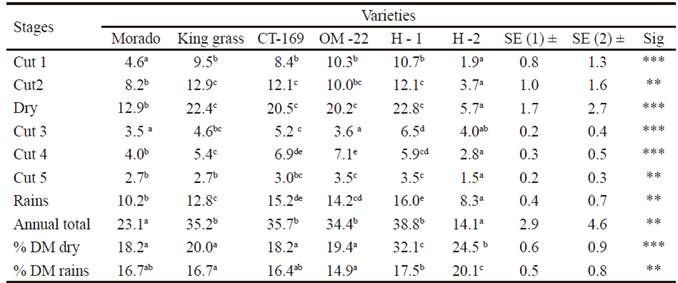
abcdeDifferent letters in the same line differ significantly at P<0.05 (Duncan, 1955).
(1). SE corresponding to treatments Morado, king grass, CT-169 and OM-22. (2). SE corresponding to treatments H-1 and H-2.
** P<0.01 *** P<0.001
In this last, there were no decades without rains (ten days in a row) but precipitations reached 653 mm within the 6 months, which is under the historical average (meteorological Station ICA) and could affect the expected yield. However, without water limitations and fertilization, Hertentains et al. (2005), in highlands of Chiriquí, Panama, with heights between 1250 y 800 mosl, precipitations between
3100 and 5900 mm/year, reported similar yields of 32.8 and 44.1 tDM/ha/year, in different localities, with Cuba OM-22 at 90 and 110 days, respectively. Regrowth age used in this researchof 90 days for dry period favord the balance of forage production in both seasons.
DM production of H-1 in rainy season was significantly higher than the rest of varieties, except CT-169. During dry period, H-2 and Morado produced less than the other four varieties and there were no differences among the four.
Caballero et al.(2016) tested the same varieties in the central area of the country with the same methodology and obtained similar yields, between 29 and 37 t of DM/ha/year, with a better distribution between dry and rainy periods. Márquez et al.(2009), in El Vigía, state of Mérida, Venezuela, reported productions of 40.9, 29.7 and 37.7 t DM/ha/year for Taiwan A-146, Morado and Maralfalfa, with cuts at 63 days and 343 kg of N/ha/year. This confirms that performance of rain, soil, sowing time and other weather factors may affect the performance of varieties, and change their order of importance. In order to make decisions on the variety to be sown, it is important to take into consideration other factors like leaf-stem relationship, establishment, persistence and distribution of annual production. According to results of this study, a potential of 40 t/DM/ha/year seems logical as indication of adaptation of these varieties, although Morado used in this study, is close to 30 t DM/ha/year.
There is a highlight in the results reported by Ramos et al. (2013), developed in Mérida, Yucatán, Mexico, where the highest yield was for OM-22 with 155 and 160 t/DM/ha/year, with the use of urea or water with pig residues, respectively, and with 131 and 140 t DM/ha/year for king grass with the same treatments. These yields are very superior to the most frequent results.
Table 2 reports yields of leaves per cut, season and year. It also shows % of leaf in DM of the plant for dry and rainy period.
Table 2 Yields of leaves per cut, season and year (t DM /ha/year)
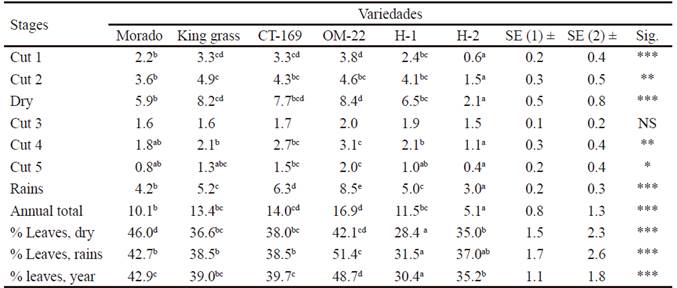
abcdDifferent letters in the same line differ significantly at P<0.05 (Duncan 1955).
(1). SE corresponding to treatments Morado, king grass, CT-169 and OM-22 (2). SE corresponding to treatments H-1 and H-2.
*** P<0.001; ** P<0.01.
Hybrid Cuba OM-22, with its progenitor Cuba CT-169, showed the highest leaf production in the year, although there were no significant differences between this last and king grass. Cuba OM-22 is highlighted due to its high percentage of leaves (49 %), in which is significantly superior to the rest of varieties. Advantages of OM-22 as leaf producer are due to a superior wide and thickness of leaf (see table 10).
Morado follows in leaf proportion, but not in yield. This purple cultivar was introduced in Cuba from Venezuela, suposedly it was obtained from a self pollinized progeny of Merkeron grass, and it was released as Pennisetum purpureum at the Experimental Station of Tiffton, Georgia, U.S.A. (Clavero 1994). It should be pointed out that H-2 (a hybrid between Morado and glaucum) showed, in this evaluation, a poor performance for the evaluated indicators, very different to hybrids purpureum x glaucum, Cuba OM-22 and H-1. It is usual to find collections with several purple individuals and marked genetic difference, as the one characterized by Sousa et al. (2012).
The highest CP yields were for H-1, OM-22, CT-169 and king grass without significant differences among them. Values ranged between 3 and 3.7 t CP/ha/year (table 3). The percentage of CP was higher in rainy period than in dry period, which is related to different cutting ages. Martínez et al. (2010), described a negative linear relationship (Y=19.08-1.59x, where x is the number of cut every 14 days) between age and CP content for Cuba OM-22. Equations for Cuba CT-169 and king grass are similar. The percentages obtained between 10 and 13 % coincide with those reported by Ramos et al. (2013) and Caballero et al. (2016). Márquez et al. (2009) reported the equation CP = 17.7 - 0.18 x F (days) for Taiwan A-146, Morado and Maralfalfa, which estimates lower CP values for these varieties at 60 days of age. Vander et al. (2000) studied the quality of varieties and hybrids of elephant grass and found better quality of hybrid leaves. Although CP content depends on fertilization, age of cut, relation leaf-stem of the variety, season and other factors, it is possible to use linear equations to predict CP content of elephant grass under specific agro-ecosystems.
Table 3 Yields of crude protein per cut, season and year (t/ha/year) Varieties
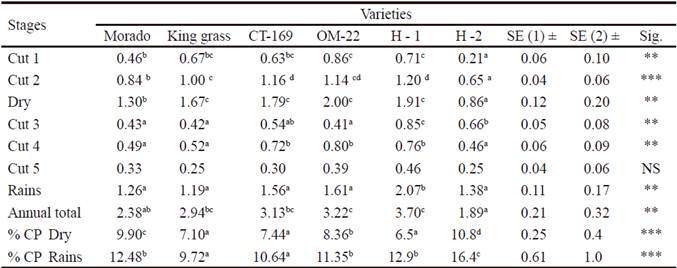
abcdeDifferent letters in the same line differ significantly at P<0.05 (Duncan 1955).
(1). SE corresponding to treatments Morado, king grass, CT-169 and OM-22. (2). SE corresponding to treatments H-1 and H-2.
** P<0.01 *** P<0.001
Studied varieties were selected for their characteristics as forage plants. Under the conditions of this study (table 4), there are no substantial differences in the percentage of CF of the varieties. Only Morado, in dry season, showed lower contents (33.9). The rest of the varieties presented a narrow range between 35 and 36.2% of CF without significant differences among them. The hybrid H-1 stands out because it is significantly different with 39.5 % of CF in the dry season.
Table 4 Yields of crude fiber per cut, season and year (t/ha/year) Varieties
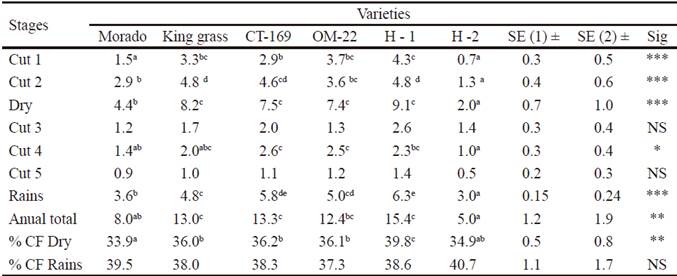
abcdeDifferent letters in the same line differ significantly at P<0.05 (Duncan, 1955).
(1). SE corresponding to treatments Morado, king grass, CT-169 and OM-22. (2). SE corresponding to treatments H-1 and H-2.
*** P<0.001; ** P<0.01
The inclusion of elephant grass into biomass production programs for energy purposes or the production of cellulose in the last 20 years (Woodardk and Prine 1993) increases the interest in crude fiber content although with different objectives.
Even in adverse climatic conditions, Xi-feng et al. (2012) used a hybrid of Pennisetum americanum × P. purpureum to evaluate the performance and characteristics of biomass for use as energy material in Beijing, China. They report a production of 40.14 to 48.5 t DM/ha, with a caloric value of 17.02 MJ/kg. The content of cellulose, hemi-cellulose, lignin and ash was 36.15; 21.01; 8.92; and 9.6 % respectively. They concluded that the Pennisetum hybrid is an excellent herbaceous plant for energy because of its high yield and quality with the disadvantage that it does not survive winter.
In this study, the thermal sum for each period between cuts was studied. Table 5 shows mean temperatures recorded and used per month.
Cuts 1 and 2 corresponding to dry period, time of lower temperatures, presented, in 90 days, values of thermal sum similar to cuts 3 and 4 with 60 days (table 6).
Tabla 7 Yield of dry matter per degree of temperature belonging to the thermal sum over 9 ºC , kg/ degree
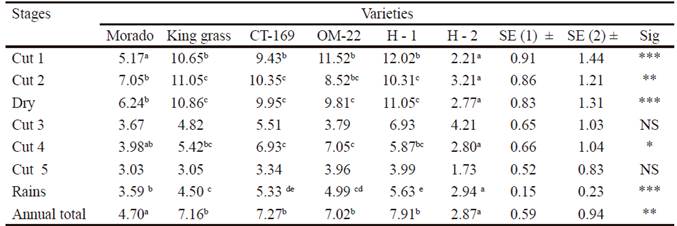
abcdeDifferent letters in the same line differ significantly at P<0.05 (Duncan 1955).
(1). SE corresponding to treatments Morado, king grass, CT-169 and OM-22.
(2). SE corresponding to treatments H-1 and H-2. ** P<0.01 *** P<0.001
Table 8 Yield of crude fiber per degree of temperature belonging to the thermal sum over 9 ºC , kg/ degree

abcdeDifferent letters in the same line differ significantly at P<0.05 (Duncan, 1955).
(1). SE corresponding to treatments Morado, king grass, CT-169 and OM-22. (2). SE corresponding to treatments H-1 and H-2.
** P<0.01 *** P<0.001
Table 9 Yield of crude protein per degree of temperature belonging to the thermal sum over 9 ºC , kg/ degree

abcdeDifferent letters in the same line differ significantly at P<0.05 (Duncan, 1955).
(1). SE corresponding to treatments Morado, king grass, CT-169 and OM-22. (2). SE corresponding to treatments H-1 and H-2.
** P<0.01 *** P<0.001
Yields of dry season with 2063 ºC of thermal sum were higher than those of rainy season with 2844ºC. Productive responses by accumulated growth degree over 9 ºC are shown in table 7, 8 and 9 for the yield of DM, CF and CP, respectively.
The same tendencies already discussed for yields are appreciated. The response of varieties by degree of accumulated growth is similar for CT-169, king grass, Cuba OM-22 and H-1. These last hybrid varieties tend to superior values in the coldest stage but did not show statistical differences, so more specific designs or analyzes will have to be conducted to determine more accurately the base temperature (Tb). Villa Nova et al. (2007) proposed alternative methods to determine Tb, where they include factors such as photoperiod, temperatures, and growth stages.
In this research, different cutting ages were established for dry and rainy season with the objective of favoring the productive balance between these two periods, taking into account recommendations of Herrera and Ramos (2005).
From the thermal sum point of view, more balanced yields were also expected.
Herrera and Ramos (2005) and Martínez et al. (2010) pointed out that biomass accumulation and quality in the cultivars king grass, Cuba OM-22 and Cuba CT-169 depends, in the first instance, on the age of cut.
In this study, there were higher yields in the two cuts of dry period (every 90 days) than in the three cuts of the rainy period (every 60 days). It cannot be specified whether this was a result of climatic conditions of rainy period, the highest cut age in dry period or other factors that cause this performance.
Therefore, it is necessary to continue studying the relationship between age, quality and degrees of accumulated growth in elephant grass to produce biomass for animal feed or for energy purposes or fiber production.
Table 10 shows contents of Ca, P, ashes, plant digestibility and some characteristics of leaves and stems obtained as mean of the 5 cuts made. There were no significant differences in digestibility and ashes, but the highest values of calcium and phosphorus of Cuba OM-22 variety are highlighted, with significant differences with the rest of the varieties. It is also important the superiority of OM-22 in the width and thickness of the leaf with a length similar to Cuba CT-169 but much higher than the rest of the varieties. In addition, stem diameter in the third internode showed significant differences in favor of OM-22 variety. The absence of villi on leaves of OM-22 should be mentioned as an attractive factor.
Table 10 Some chemical characteristics of the whole plant and phenological measures that expressed the studied varieties as mean of 5 cuts (% of DM and cm, respectively)
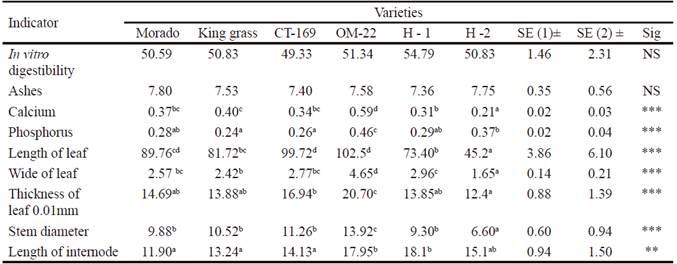
abcdeDifferent letters in the same line differ significantly at P<0.05 (Duncan, 1955).
(1). SE corresponding to treatments Morado, king grass, CT-169 and OM-22.
(2). SE corresponding to treatments H-1 and H-2.
** P<0.01 *** P<0.001
Conclusions and Recommendations
There were no large differences in annual DM yields among four of the studied varieties. However, there are differences in leaf yield in favor of Cuba OM-22 and Cuba CT-169 varieties for their phenotypical properties. The differences are in the length, width and thickness of leaves, which can influence the performance of nutrients such as CP, Ca and P.
It is recommended to pay more attention to phenotypical characteristics of the varieties, especially leaf production, which, together with other local situations such as establishment, persistence, type of cut and response to climate, may influence on the selection of the cultivar to be planted according to the productive purpose.











 text in
text in 




